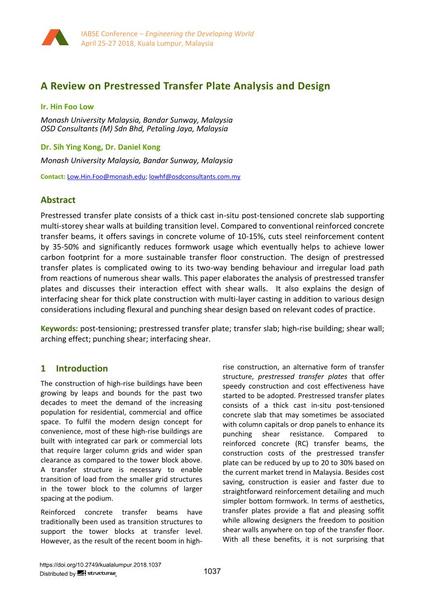A Review on Prestressed Transfer Plate Analysis and Design

|
|
|||||||||||
Bibliographic Details
| Author(s): |
Hin Foo Low
(Monash University Malaysia, Bandar Sunway, Malaysia OSD Consultants (M) Sdn Bhd, Petaling Jaya, Malaysia)
Sih Ying Kong (Monash University Malaysia, Bandar Sunway, Malaysia) Daniel Kong (Monash University Malaysia, Bandar Sunway, Malaysia) |
||||
|---|---|---|---|---|---|
| Medium: | conference paper | ||||
| Language(s): | English | ||||
| Conference: | IABSE Conference: Engineering the Developing World, Kuala Lumpur, Malaysia, 25-27 April 2018 | ||||
| Published in: | IABSE Conference Kuala Lumpur 2018 | ||||
|
|||||
| Page(s): | 1037-1044 | ||||
| Total no. of pages: | 8 | ||||
| DOI: | 10.2749/kualalumpur.2018.1037 | ||||
| Abstract: |
Prestressed transfer plate consists of a thick cast in-situ post-tensioned concrete slab supporting multi-storey shear walls at building transition level. Compared to conventional reinforced concrete transfer beams, it offers savings in concrete volume of 10-15%, cuts steel reinforcement content by 35-50% and significantly reduces formwork usage which eventually helps to achieve lower carbon footprint for a more sustainable transfer floor construction. The design of prestressed transfer plates is complicated owing to its two-way bending behaviour and irregular load path from reactions of numerous shear walls. This paper elaborates the analysis of prestressed transfer plates and discusses their interaction effect with shear walls. It also explains the design of interfacing shear for thick plate construction with multi-layer casting in addition to various design considerations including flexural and punching shear design based on relevant codes of practice. |
||||
| Keywords: |
high-rise building post-tensioning punching shear shear wall prestressed transfer plate transfer slab arching effect interfacing shear
|
||||
